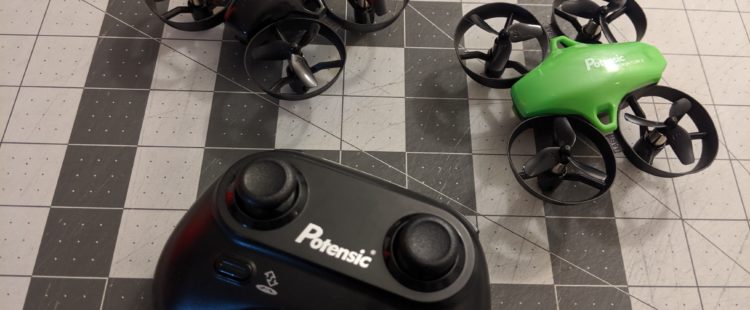
We had an unusually warm day in February and I seized the opportunity to start flying outside. I briefly tried the back yard but decided it was a bad idea because the tree line there seemed tailor made to snag my drone, and I was scared of getting it stuck high enough I wouldn’t be able to get to it. There were also some low spots in the yard that really held onto water and I really didn’t want to crash into one of those and ruin the quad. The front yard was much better to start out in with less trees. I could use the road, the sidewalks, and fly in the neighbors yards with less chance of bothering anyone.
As much as I’d been looking forward to it, I wasn’t prepared for having to start over again with my comfort level. Beyond the fear of getting stuck somewhere, moving outside posed a whole new set of challenges for me to keep in mind, and I felt like I had when I first started.
My Acrobee only weighs 30 grams with the battery, so I couldn’t fly if there was very much wind. Although I did find that as long as the wind was consistent I could fly in stronger winds than if it was gusting a lot. I could compensate in cases where the wind was consistent, at least up to a certain point.
Once I got comfortable, flying outside really ramped up my excitement in the hobby. After being stuck inside for months, it was a real thrill to be able to get some speed and altitude and try some tricks.

One surprise with flying outside was I reminded that cold weather makes plastic brittle. The whoop frame that I’d been flying for a couple of months started to crack after a few crashes. Initially I tried some super glue, which is my default adhesive for fixing things. It didn’t work well for frame repairs though. It’s too brittle. Repaired spots just broke again after the next impact. Next I tried E6000 adhesive. I’d like to say I did a bunch of research and settled on it, but the truth is I found it in a drawer in the kitchen and decided to try it. E6000 turned out to be perfect for what I needed. It stuck well to the plastic frame and dried to a rubbery consistency so it absorbed impacts pretty well. As a bonus it was easy to clean off of my fingers afterwards.
Despite my best efforts, I did eventually crash into water.
Around Easter time while flying at my Uncle’s house I ended up glancing off a tree branch and crashing into a tiny stream at the back of their property. I could see water at the bottom of the camera lens, so I yanked off my goggles and ran back to get it out of the water and unplug the battery. I was a little panicked but not too badly since the video feed was still active after it hit the water. I figured since it was still transmitting that it should be fine once it dried out.
Once we got home, I decided before I’d plug it back in again I should clean it to make sure that no mineral deposits had been left behind after the water evaporated, which I figured might cause a short. Unfortunately all I had in the house was regular isopropyl alcohol intended for first aid use, which wasn’t pure enough for cleaning electronics. For that I needed 99.9% pure alcohol. So I had to order some and had to wait a few days before I could test to see if the quad was still working or not. Once it came, I took the quad apart and cleaned the flight board top and bottom as well as the back of the camera. I then let them set for an hour to air dry before plugging in a fresh battery to see if it worked. Everything came back up and seemed to be working the same as they had before their water landing. So I got lucky.
I haven’t had any more water accidents since then, and hopefully I don’t, but it was nice to know that I could recover from one. I just don’t want to test my luck on that again.














